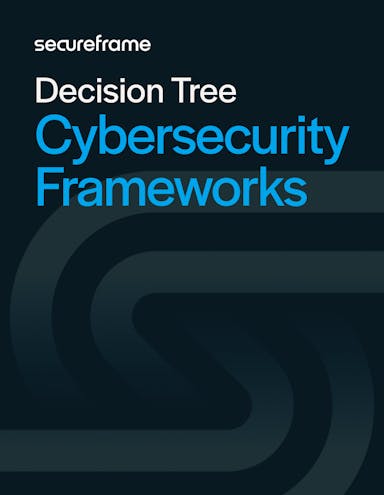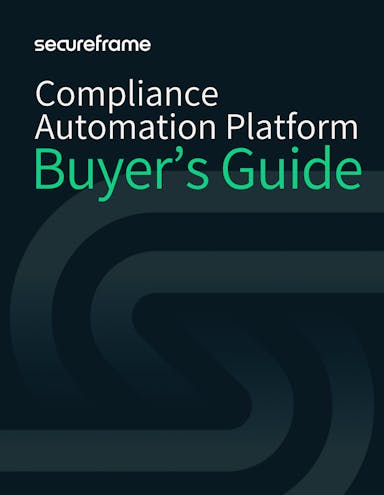
Cybersecurity Compliance 101: How to Select Frameworks, Meet Requirements, and Pass Audits
Emily Bonnie
Senior Content Marketing Manager
When most people hear the word “compliance,” they think of red tape, auditors, and long lists of rules. But in the context of cybersecurity, compliance is much more than just meeting requirements to check a box. It’s about building a foundation of trust with your customers, protecting your business from costly risks, and creating a framework that supports growth over the long term.
At its core, cybersecurity compliance means aligning your business’s security practices with recognized standards, laws, or frameworks. These standards might be required by regulators, industry groups, or major customers, depending on what type of data you handle. But beyond obligations, compliance is a way to demonstrate to the outside world and to your own team that security isn’t an afterthought, it’s a priority.
Why cybersecurity governance, risk, and compliance matters for your business
The reality is that no organization is too small to be a target. Cybercriminals don’t just go after Fortune 500 companies; they often look for the easiest path in, and that can be a startup with a weak cloud configuration or a mid-sized business with limited security staff. A single breach can have devastating consequences, from data loss and customer churn to regulatory fines and lawsuits. Beyond the direct costs, businesses also risk exposing sensitive information that erodes customer trust and disrupts business operations.
According to IBM’s 2024 Cost of a Data Breach Report, the global average cost of a breach has climbed above $4.5 million. For smaller organizations, a breach may not just mean a financial hit, it can threaten the survival of the business altogether. On top of the direct costs, harder-to-quantify losses include reputational damage, slowed sales cycles, and diminished trust from customers, partners, and investors.
This is why compliance is so critical. By aligning your security program with established standards, you’re not only meeting requirements but also implementing proven ways to mitigate cybersecurity risk. Compliance helps you proactively strengthen your defenses, reducing the likelihood of a breach in the first place.
The business benefits of cybersecurity compliance
While compliance may start as a requirement, whether from regulators, customers, or your board, it quickly becomes a business enabler. Companies that can show strong security compliance practices often find it easier to close deals, especially in industries like healthcare, finance, or government contracting where data protection is non-negotiable. For many buyers, seeing proof of compliance (for example, a SOC 2 report or ISO 27001 certificate) is the deciding factor in choosing a vendor.
Compliance also forces organizations to create repeatable processes for risk management, security training, and vendor oversight. These improvements drive efficiencies that extend well beyond the IT department. Teams collaborate more effectively, executives get better visibility into cybersecurity risks, and employees gain clarity about their role in keeping data safe.
Another key benefit is the ROI of security compliance. Yes, compliance requires upfront effort and investment. But the cost of non-compliance, whether in the form of fines, lost contracts, or a breach response, almost always outweighs the cost of building a strong program. Regulatory penalties can easily reach into the millions. For example, violations of the General Data Protection Regulation (GDPR) can carry fines of up to 4% of annual global turnover or €20 million, whichever is greater. In the US, industries like healthcare face steep fines under the Health Insurance Portability and Accountability Act (HIPAA) for security failures, and financial services companies can face sanctions from the SEC.
Investing in compliance is investing in business resilience. Instead of scrambling to react when something goes wrong, your business is prepared, protected, and positioned to respond effectively.
Compliance as a key part of your cybersecurity strategy
The best way to think about compliance is not as a one-time project, but as an ongoing part of your cybersecurity strategy. Cyber threats evolve constantly, and so do the regulations and standards that govern data protection. That means compliance isn’t a static achievement. It’s a continuous process of governance, risk management, and control.
When done right, compliance creates a virtuous cycle: governance ensures leadership prioritizes security, risk management helps identify and mitigate threats, and controls keep protections effective. Together, these practices support a stronger security posture and help you stay ahead of both attackers and auditors.
Recommended reading

Calculating the ROI of Security Compliance for Small Businesses
Cybersecurity compliance standards and frameworks
When you start exploring security compliance for your organization, one of the first things you’ll notice is that there isn’t just one universal rulebook. Instead, there are dozens of cybersecurity frameworks and regulatory standards, each created to address specific risks, industries, or geographies. That can feel overwhelming at first, but understanding the landscape is the first step toward building a cybersecurity strategy that’s both compliant and effective.
Regulatory frameworks vs. industry standards
Not all compliance frameworks are created equal. Some are legally required, while others are voluntary standards that have become widely adopted best practices. For example:
- Regulatory frameworks are created and enforced by government agencies or industry regulators. Think of laws like GDPR in Europe, HIPAA in US healthcare, or FedRAMP for cloud providers that want to work with US federal agencies. If you’re subject to one of these cybersecurity regulations, compliance isn’t optional.
- Industry standards are developed by professional bodies or coalitions to raise the bar for security measures across sectors. Examples include SOC 2, which was developed by the AICPA, or ISO/IEC 27001, created by the International Organization for Standardization and International Electrotechnical Commission. These aren’t legal requirements, but customers often demand them as proof of strong security practices.
In practice, many businesses have to juggle both: meeting mandatory regulatory requirements while also pursuing industry standards that support sales and customer trust.
A closer look at the most common cybersecurity frameworks
There are dozens of security frameworks out there, but a handful of them come up again and again because they’ve become benchmarks in the world of IT standards management and cloud security frameworks.
- SOC 2: Designed for cloud service providers, SOC 2 evaluates how well your organization manages customer data across five trust criteria: security, availability, processing integrity, confidentiality, and privacy.
- ISO/IEC 27001: An international standard for establishing and maintaining an information security management system (ISMS).
- NIST Cybersecurity Framework (CSF 2.0): Originally created for critical infrastructure, now widely used as a flexible way to manage and improve cybersecurity.
- NIST 800-53: A detailed catalog of security and privacy controls used across federal systems, and the foundation of many other frameworks including FedRAMP.
- NIST 800-171: A US standard for protecting controlled unclassified information (CUI) in non-federal systems.
- CMMC (Cybersecurity Maturity Model Certification): A US Department of Defense program that builds on NIST 800-171 to certify contractors and subcontractors handling defense-related data.
- FedRAMP: A US government program that standardizes cloud security requirements for vendors serving federal agencies.
- PCI DSS: A global standard for organizations that handle cardholder data. PCI DSS compliance is mandatory for merchants and service providers that process or store payment or credit card information.
- HIPAA: US legislation governing how healthcare organizations and their vendors safeguard protected health information (PHI).
- SOX: A US law requiring financial institutions and public companies to implement strong data integrity and security controls.
- CCPA: California’s data privacy law that gives residents rights over how their personal data is collected, stored, and shared.
- FISMA: US legislation requiring federal agencies to implement information security programs for their information systems.
- NIS2: The European Union’s updated Network and Information Security Directive, which sets mandatory cybersecurity risk management and reporting obligations for a wide range of industries.
- DORA (Digital Operational Resilience Act): An EU regulation that sets requirements for ICT risk management, resilience, and incident reporting in financial institutions.
- CIS Controls: A prioritized set of best practices developed by the Center for Internet Security to help organizations defend against the most common cyberattacks.
- Cyber Essentials: A UK government-backed certification scheme that defines basic security measures organizations should implement to protect against cyberattacks.
- Essential Eight: An Australian government framework recommending eight prioritized mitigation strategies to improve cybersecurity resilience.
- COBIT and COSO: Broader governance and control frameworks often used by larger enterprises to align IT with business objectives.
Each of these frameworks is built with slightly different goals in mind, but most share common cybersecurity principles. They emphasize risk-based decision making, access control, monitoring, and incident response, even if the specific wording or requirements vary.
Recommended reading

Understanding Security Frameworks: 14 Common Frameworks Explained
How to choose the right cybersecurity standards for your business
With so many frameworks on the table, how do you know which ones apply to you? The answer depends on several factors:
- Industry: A healthcare provider will need to focus on HIPAA, while a fintech startup processing payments will need to address PCI DSS.
- Customers: Many enterprise customers now require vendors to have SOC 2 or ISO 27001 certification before signing contracts.
- Geography: If you collect data from EU residents, GDPR compliance is a must, regardless of where your company is headquartered.
- Government contracts: Working with the US Department of Defense means meeting NIST 800-171 and CMMC requirements.
It’s also increasingly common for businesses to pursue multiframework compliance, especially as they scale into new markets. While that sounds daunting, the good news is that many frameworks overlap. A well-designed cybersecurity strategy allows you to implement controls once and map them across multiple standards, saving time and reducing audit fatigue.
The key is to view frameworks not as a burden, but as building blocks for a stronger cybersecurity strategy. By understanding where regulatory frameworks and industry standards overlap, you can create a program that satisfies multiple stakeholders, strengthens your defenses, and positions your business for growth in competitive markets.

Cybersecurity Frameworks Decision Tree
With so many cybersecurity frameworks available, understanding which apply to your business can be a challenge. Use this decision tree as a starting point to understand which frameworks align with your unique requirements and regulatory obligations.
Common cybersecurity compliance requirements
If you look across different frameworks, you’ll notice that many of the requirements overlap. That’s because while each framework has its own language and priorities, many are built on a similar foundation of cybersecurity best practices.
Understanding these recurring requirements is useful for two reasons. First, it helps demystify compliance by showing that many of the fundamentals are consistent, no matter which framework you’re working toward. Second, it allows you to design a compliance program that’s adaptable, so you don’t have to start from scratch every time a new customer, auditor, or regulation enters the picture.
Here are some of the most common cybersecurity requirements that appear across frameworks.
Access controls
Access control is a fundamental cybersecurity principle, and it shows up in every framework. The goal is to ensure that only the right people, with the right level of permission, can access sensitive systems or data.
That starts with user provisioning and deprovisioning. When a new employee joins, their access should be set up quickly and aligned with their role. When they leave, their access should be removed immediately. Many breaches stem from “orphaned accounts” that remain active after an employee or contractor departs.
Frameworks also expect organizations to implement the principle of least privilege (granting employees the minimum access necessary to do their jobs) and to review permissions regularly. Multi-factor authentication (MFA) has become a near-universal requirement as well, since it drastically reduces the risk of compromised credentials that can be used in an attack.
On a practical level, auditors often look for evidence that access reviews happen at least quarterly, that permissions are documented, and that there are controls in place for high-risk accounts such as system administrators.
Identity and authentication management
Closely tied to access controls, identity management ensures you know exactly who is accessing your systems. Compliance frameworks often require centralized identity providers, single sign-on solutions, and regular reviews of user accounts to prevent unnecessary or unauthorized access.
Security awareness and training
Human error is often the weakest link in cybersecurity. That’s why nearly every framework requires ongoing cybersecurity training so employees understand their responsibilities. This typically includes phishing awareness, secure data handling practices, and reporting suspicious activity. Many organizations also use tabletop exercises or simulated phishing campaigns to keep staff alert.
Data encryption
Protecting data at rest and in transit is a recurring requirement across frameworks. Whether it’s customer records, payment card information, or sensitive government data, encryption ensures that even if data is intercepted or stolen, it cannot be easily read or exploited.
Incident response planning
No security program can prevent every attack. That’s why many compliance frameworks require an incident response plan. This is a documented process for detecting, responding to, and recovering from security events. It typically covers escalation paths, roles and responsibilities, communication procedures, and post-incident reviews.
Risk management
Effective compliance programs are rooted in strong risk management. Frameworks require organizations to identify potential threats, assess their likelihood and impact, and put controls in place to mitigate them. A risk register or risk assessment process is often required, and some frameworks mandate periodic updates as new risks emerge.
Recommended reading

10 Popular Risk Management Frameworks & How to Choose Between Them
Logging and monitoring
Continuous monitoring is another common theme. Frameworks require organizations to implement logging and monitoring tools to detect suspicious activity, generate alerts, and provide an audit trail. This is critical not only for security but also for demonstrating compliance to auditors.
Business continuity and disaster recovery
Compliance isn’t just about preventing incidents, it’s also about ensuring resilience when something goes wrong. That’s why many frameworks require business continuity and disaster recovery plans. These plans outline how to maintain business operations, recover data, and restore systems after a disruption.
Change management
Uncontrolled changes to systems can introduce vulnerabilities. Frameworks often require formal change management processes that document, test, and approve modifications to IT systems. This ensures that updates are intentional, reviewed, and implemented securely.
Policies and documentation
Policies are often the most visible evidence of compliance. Frameworks typically require a library of written security policies that cover areas like access control, acceptable use, incident response, data classification, vendor management, and business continuity. These policies not only guide employee behavior but also demonstrate to auditors that security is formalized and enforced.
Documentation doesn’t stop with policies. Auditors will also want to review evidence that shows security policies and procedures are actually followed. This might include screenshots of MFA settings, access review logs, training completion records, or vendor assessment reports. One of the biggest challenges in compliance is gathering and organizing this evidence, which is why many organizations turn to compliance automation platforms to streamline the process.
Physical security
Although digital threats dominate headlines, physical access to servers, laptops, or even printed records can be just as dangerous. Frameworks often require businesses to restrict physical access to facilities, use badge systems, and secure devices against theft or tampering.
Privacy and data protection
Especially under regulations like GDPR and HIPAA, privacy requirements are critical. Organizations must ensure that personal data is collected, processed, and stored lawfully, and that individuals’ rights are respected. This may include consent management, data minimization, and processes for handling subject access requests.
Vendor risk management
Third-party vendors are one of the most overlooked sources of risk, yet they’re a common attack vector. If your payroll provider, marketing platform, or cloud infrastructure provider suffers a breach, your business can be impacted too. That’s why frameworks like SOC 2, HIPAA, and NIST standards require vendor risk management programs.
This typically includes:
- Due diligence before onboarding vendors. Companies need to evaluate whether a vendor has appropriate security controls in place. For higher-risk vendors, this may involve requesting SOC 2 reports, penetration test results, or security questionnaires.
- Contractual requirements. Contracts should spell out data protection obligations, breach notification timelines, and compliance responsibilities.
- Ongoing monitoring. Risk doesn’t end once a vendor is signed. Periodic reviews, automated monitoring, and requesting updated reports or certifications help ensure vendors maintain their security posture.
Auditors will often ask to see a vendor inventory (sometimes called a vendor register) and evidence of reviews or risk assessments for critical vendors. A strong vendor risk management process not only satisfies compliance but also protects your supply chain from cascading risks.
Recommended reading

A Simple Guide to Vendor Risk Management: How to Stop Vendor Breaches
Regular assessments and testing
Finally, most frameworks typically require periodic assessments to verify that controls remain effective. This can include vulnerability scans, penetration tests, internal audits, and periodic reviews. The goal is to prevent security from becoming a “set it and forget it” process.
By understanding and implementing these common requirements, businesses can build a foundation that satisfies multiple frameworks and strengthens their overall security posture. In many ways, these are the cybersecurity best practices every organization should follow, regardless of which specific compliance standards they’re working toward.
Cybersecurity audits and assessments
One of the most important realities of cybersecurity compliance is that you can’t just say you’re secure — you have to prove it through audits and assessments.
Most compliance frameworks require some form of independent review to verify that your organization’s controls are working as intended. Even when a third-party audit isn’t strictly required, internal assessments are critical for maintaining strong cybersecurity hygiene and ensuring your program keeps pace with evolving risks.
What is a cybersecurity audit?
A cybersecurity audit is a structured, formal review of your security policies, procedures, and controls. An external auditor or assessor evaluates whether your organization meets the requirements of the framework or regulation you’re pursuing.
For example, if you’re working toward SOC 2, you’ll hire a CPA firm licensed to conduct a SOC 2 Type I or Type II audit. If you need ISO 27001 certification, you’ll engage an accredited certification body for a two part assessment. For PCI DSS, you may need a Qualified Security Assessor (QSA). These independent experts request documentation, interview staff, and examine evidence to confirm that you have the required controls in place and they are operating effectively.
The outcome of the audit is usually a formal report or certificate, which allows you to demonstrate compliance to customers, regulators, and partners.
Which frameworks require outside audits?
Here’s where things get nuanced. Not all frameworks treat audits the same way:
- Certification and attestation frameworks like SOC 2, ISO 27001, FedRAMP, and PCI DSS explicitly require an independent third-party audit or assessment. These are recurring events (usually annual or biennial) where auditors validate that your program continues to meet requirements.
- Regulatory frameworks like HIPAA or GDPR don’t have a built-in requirement for recurring third-party audits. Instead, organizations are expected to perform their own internal risk assessments and maintain compliance continuously. External audits may only occur if there’s a breach, complaint, or regulatory investigation. For example, the US Department of Health and Human Services’ Office for Civil Rights (OCR) can audit healthcare providers after a HIPAA complaint or violation.
This distinction often catches companies off guard. Even if your framework doesn’t require a standing certification, regulators can still investigate your practices and impose penalties if something goes wrong.
What’s involved in an external audit?
While the specifics vary by framework, most third-party audits follow a similar process:
- Scoping. The auditor and your team define which systems, processes, and controls will be included in the assessment.
- Documentation review. You provide written policies, procedures, and risk assessments.
- Evidence collection. The auditor requests proof that policies are followed in practice, such as screenshots of security settings, access logs, or training completion records.
- Testing. The auditor may test controls to confirm they’re working. For example, they might check that inactive user accounts are deactivated within the required time frame.
- Interviews. Key staff members may be asked to explain processes or demonstrate knowledge of security responsibilities.
- Report. The auditor delivers a report noting whether your controls passed, and if not, where remediation is required.
Audits can feel daunting, but they are also an opportunity. A good auditor doesn’t just mark boxes; they highlight weaknesses in your program and provide valuable insight into where you can strengthen your security posture.
Internal audits and ongoing assessments
Even if your chosen framework doesn’t mandate an external audit, that doesn’t mean you’re off the hook. Most compliance standards expect organizations to conduct periodic internal audits or self-assessments. The goal is to make sure controls are still effective over time and adapt to changes in your risk profile.
For example, if you expand into a new market or adopt a new cloud service, your risk landscape changes. Regular internal audits help you catch gaps early and avoid unpleasant surprises in your next external review.
An internal audit might involve:
- Reviewing policies and confirming they’re up to date
- Checking that user access rights are still appropriate
- Verifying that security training has been completed by all staff
- Running through an IT security audit checklist to ensure nothing is overlooked
Some organizations build internal audit teams, while others assign responsibility to compliance managers or risk officers. Either way, the principle is the same: trust, but verify.
Audits are point-in-time evaluations, but compliance requires continuous vigilance. Many organizations supplement periodic audits with ongoing cybersecurity assessments, such as:
- Vulnerability scans to identify weaknesses in networks or applications
- Penetration tests to simulate cyberattacks and test defenses
- Tabletop exercises to rehearse how the team would respond to incidents
- Third-party assessments of vendors and suppliers
Audits can be stressful, but they serve an important purpose. They validate that your organization isn’t just claiming to follow cybersecurity best practices, you’re actually living them. They also build credibility with stakeholders. Customers, investors, and regulators want assurance that your security posture has been independently verified.
And perhaps most importantly, audits create accountability. By preparing for them regularly, your organization avoids complacency and keeps cybersecurity hygiene at the forefront of operations.
Recommended reading

How to Do an Internal Cybersecurity Audit + Checklist
Cybersecurity compliance checklists
When you’re navigating compliance for the first time, it’s easy to feel overwhelmed. Every framework comes with dozens and sometimes hundreds of requirements.
That’s where compliance checklists become a practical tool. Instead of “make sure your vendors are secure,” a checklist might say “maintain a vendor inventory and review SOC 2 reports annually.” Instead of “protect customer data,” a checklist might specify “encrypt data at rest and in transit with AES-256 and TLS 1.2 or higher.”
A checklist gives you a structured way to compare your current practices against a framework’s specific requirements. It helps you spot gaps, organize evidence, and plan the work needed to close those gaps before an auditor or regulator comes knocking.
Downloadable cybersecurity compliance checklists
To help you understand requirements and organize your compliance efforts, we’ve created a set of downloadable checklists for some of the most common security frameworks:
- SOC 2 Type II compliance checklist
- ISO 27001 compliance checklist
- FedRAMP 20x Low compliance checklist
- NIST 800-171 compliance checklist
- NIST CSF compliance checklist
- CMMC Level 1 Compliance Checklist
- CMMC Level 2 Compliance Checklist
- CMMC Level 3 Compliance Checklist
- DFARS Compliance Checklist
- GovRAMP compliance checklist
- CIS Critical Security Controls Implementation Checklist
- TX-RAMP compliance checklist
- CJIS Security Policy Controls Checklist
- Essential Eight Implementation Checklist
- Digital Personal Data Protection Act (DPDPA) Compliance Checklist
- GDPR compliance checklist
- CCPA compliance checklist
- CPRA compliance checklist
- HIPAA compliance checklist
- PCI DSS compliance checklist
- NIS2 compliance checklist
- Microsoft SSPA compliance checklist
- NYDFS NYCRR 500 compliance checklist
- NIST 800-53 compliance checklist
- Regulatory compliance checklist
- EU AI Act compliance checklist
- Internal security assessment checklist
These resources are designed to save you time, reduce manual effort, and give you a repeatable way to evaluate your compliance posture. But it’s also important to note that while a checklist is a great starting point, it isn’t the finish line.
Once you’ve mapped your current state against requirements, the next step is remediation: updating policies, strengthening controls, and collecting evidence. Over time, you’ll want to move from periodic checklist reviews to continuous compliance, where monitoring and evidence collection happen automatically. That way, you’re always audit-ready.
Cybersecurity compliance consulting and outsourcing
Building and maintaining a compliance program is no small task. It requires time, expertise, and resources that many organizations don’t always have in-house. That’s why many companies look outward for support, either by hiring a compliance consultant or working with a managed service provider (MSP) or managed security service provider (MSSP).
At first glance, these options might seem interchangeable. Both involve paying an outside party to help you meet your compliance goals. But in reality, they provide very different types of support. Understanding the difference will help you make the right investment for your business.
Compliance consultants
A compliance consultant is usually an individual or firm that provides project-based expertise. Consultants are often engaged for a specific purpose, like preparing for a SOC 2 audit, conducting a HIPAA gap assessment, or helping a financial services company interpret SOX requirements.
Consultants are a good fit if you need expert guidance for a defined project or want a short-term boost in knowledge. However, their involvement usually ends once the engagement is complete, which means maintaining compliance falls back on your team.
MSPs and MSSPs
Managed service providers (MSPs) and managed security service providers (MSSPs) are more operational in nature. Instead of advising you on what to do, they actually take over parts of your IT or security function.
MSPs handle broader IT management, like managing servers, endpoints, and networks. They may help implement compliance-related requirements but aren’t typically focused on security alone.
MSSPs specialize in security services, such as monitoring your network for threats, managing firewalls, and responding to incidents. While their work supports compliance, their role is more about executing technical defenses than documenting and demonstrating controls.
These providers are often engaged long-term on a subscription basis. For small businesses (1–50 users), MSP fees typically range from $70 to $150 per user per month. A 25-user company might pay between $1,750 and $3,750 per month, depending on service depth and support levels.
Mid-sized businesses (50–250 users) generally fall into a $100 to $250 per user per month range. For larger enterprise clients, things are more complex. Rates for enterprises (250+ users) can climb to $150–$500 per user per month, translating to $75,000 to $250,000 per month in total MSP expenses.
MSSPs, given their 24/7 monitoring and security-heavy services, usually price between $2,000 and $5,000 per month for small to mid-sized businesses. Costs can escalate sharply for more advanced services like XDR or continuous compliance management.
Making the right choice often comes down to your needs. If you want someone to guide your team through a specific compliance framework, a consultant may be the right fit. If you want to outsource day-to-day IT or security operations, an MSP or MSSP may be the better option. Some organizations even use both, with consultants setting strategy and MSPs executing the technical work.
Recommended reading

Compliance Outsourcing: New Data Measures the ROI of Compliance Automation and MSSPs
The limitations of outsourcing compliance
While outsourcing compliance can fill critical gaps, it comes with trade-offs. You’re still responsible for compliance outcomes, even if a third party is doing the work. Regulators and auditors won’t accept “our MSP didn’t set that up” as an excuse for non-compliance. Plus, outsourcing can get expensive over time, especially for growing businesses that need to scale efficiently.
Plus, for many organizations, the biggest challenge with compliance isn’t knowing what needs to be done. It’s keeping up with the endless documentation, evidence collection, and monitoring required to maintain and prove compliance over time. Consultants can provide guidance, and MSPs or MSSPs can manage certain functions, but both approaches often leave businesses with high costs, fragmented processes, and limited scalability.
This is why more companies are exploring compliance automation platforms as a modern alternative. These tools reduce reliance on consultants and MSPs by automating key compliance tasks like evidence collection, risk assessments, and monitoring, making compliance significantly more efficient and cost-effective. Instead of relying on manual work or expensive outsourcing, automation platforms bring your compliance program into a centralized, streamlined system that’s designed to grow with your business.
What compliance software can (and can’t) do
Compliance software acts like a connective layer across your entire security and compliance program. It integrates with the tools and systems you already use and automatically pulls in data to confirm whether your controls are in place and operating effectively. That data becomes the evidence you’ll need for audits, collected and organized without dozens of screenshots and spreadsheets.
These platforms can also run automated risk assessments, flagging gaps in your security program and mapping them to specific compliance requirements. They make it possible to manage vendor risk more effectively, track remediation through dashboards, and even follow pre-built workflows tailored to specific security frameworks. In short, they remove much of the heavy lifting so compliance doesn’t become a full-time job for your team.
Instead of staff spending hours gathering logs, evidence is captured and validated automatically so your team can focus on more strategic projects. Processes are consistent and repeatable, which reduces errors and makes audits far less stressful. And because the system is always on, you’re building toward continuous compliance rather than scrambling to prepare for an audit once a year.
For leadership, the benefits are just as tangible. Dashboards make it easy to see where you stand across multiple frameworks at once, how risks are trending, and whether gaps are being addressed on schedule. As the business grows, automation provides a scalable foundation, allowing you to expand into new markets or frameworks without reinventing your entire compliance program.
But it’s important to be realistic about what compliance software can’t do. No platform can make leadership decisions for you about how much risk you’re willing to accept, or replace the responsibility of executives to set the right tone for governance. Automation also doesn’t remove the need for an outside auditor if a framework like ISO 27001 or SOC 2 requires one.
In other words, the technology takes care of the repetitive, time-consuming tasks, but the accountability for compliance still rests with your organization.
Recommended reading

Why Compliance Automation is a Strategic Advantage for Modern Organizations
Choosing the right compliance automation platform
If you’re evaluating compliance automation tools, the best platforms are those that can adapt to your needs over time. Look for a solution that will help you save time, reduce errors, and scale your compliance program as your business grows. As you compare options, here are some of the most important features to look for:
- Advanced automation: Deep integrations with your cloud providers, identity systems, and security tools that go beyond surface-level data. The best platforms automatically collect audit-ready evidence, continuously monitor controls, and reduce the manual effort that typically bogs down compliance.
- Comprehensive risk management: A built-in risk register, assessment workflows, and historical tracking so you can monitor how your risk profile changes over time. The ability to map risks directly to controls and assets makes it easier to see where you’re covered and where you need to improve.
- Simplified document management: A single place to organize and track your policies, audit evidence, reports, and training records. Features like version history and document collaboration prevent the chaos of juggling files across email and shared drives.
- Deep customization: Support for custom tests, controls, and frameworks so you can tailor the platform to your unique environment. Some solutions also offer customizable Trust Centers that let you share your security posture publicly to build customer trust.
- Vendor and personnel management: Tools for evaluating vendor risk, tracking vendor access to sensitive data, and storing compliance reports for easy reference during audits.
- Control mapping: The ability to map controls across multiple frameworks automatically, so you can reduce duplicate work and view your compliance status in one dashboard.
- AI capabilities: Advanced platforms use AI to streamline processes even further—whether that’s providing remediation guidance, predicting risk exposure, or automating security questionnaires that would otherwise eat up valuable time.
- Expert support: The best software is backed by experienced compliance teams who can offer specialized guidance, answer your questions quickly, and help tailor controls to your business needs. Strong customer support often makes the difference between a tool you struggle with and a partner that accelerates your program.
The right platform should make compliance faster, easier, and more sustainable not just for your next audit, but as an ongoing part of your security strategy and business operations.
Secureframe was built by security and compliance experts and offers everything you need to achieve and maintain compliance, reduce operational costs, and improve efficiency across your security program.
In the survey conducted by UserEvidence, Secureframe customers reported a range of benefits, including:
- 97% strengthened their security and compliance posture
- 95% saved time and resources obtaining and maintaining compliance
- 89% sped up time-to-compliance for multiple frameworks
- 85% unlocked annual cost savings
- 71% improved visibility into security and compliance posture
Learn how you can experience these same benefits by scheduling a demo with one of our compliance experts.

Compliance Automation Buyer’s Guide
Learn how a compliance automation platform can help streamline and scale your security and compliance efforts, then use an evaluation form to fast-track the vendor evaluation process.
FAQs
What is cybersecurity compliance?
Cybersecurity compliance means following established regulations, standards, and best practices to protect sensitive data and information systems. It ensures your organization puts the right security measures in place to prevent unauthorized access, data breaches, and other cyber risks.
What is an example of cybersecurity compliance?
A common example is a healthcare organization complying with HIPAA by encrypting patient health information, limiting access to only authorized staff, and regularly training employees on data privacy rules.
How to get cybersecurity compliance?
Achieving compliance starts with identifying which regulations or frameworks apply to your business. From there, you’ll need to implement the required controls—like access management, risk assessments, and vendor reviews—document your policies and processes, and often complete an internal or external audit to validate your program.
What is SOC 2 compliance in cyber?
SOC 2 is a widely used cybersecurity compliance framework for technology and service companies. It focuses on how organizations protect customer data across five principles: security, availability, processing integrity, confidentiality, and privacy. Passing a SOC 2 audit demonstrates to customers and partners that your systems meet these standards.
What does a cybersecurity compliance officer do?
A cybersecurity compliance officer is responsible for overseeing an organization’s compliance program. They interpret applicable regulations, ensure controls are implemented and documented, coordinate audits, manage risk assessments, and educate staff on security responsibilities.
What is a cybersecurity compliance certificate?
The Cybersecurity Compliance Certificate (CCC) is a credential that verifies an individual’s knowledge of cybersecurity compliance requirements. It’s often pursued by professionals who want to demonstrate their expertise in applying cybersecurity regulations, standards, and best practices in real-world settings.
How long does CCC certification take?
The timeline varies depending on the training provider and the learner’s pace. Many CCC programs can be completed in a few weeks to a few months, depending on whether you study part-time or full-time.

Emily Bonnie
Senior Content Marketing Manager
Emily Bonnie is a seasoned digital marketing strategist with over ten years of experience creating content that attracts, engages, and converts for leading SaaS companies. At Secureframe, she helps demystify complex governance, risk, and compliance (GRC) topics, turning technical frameworks and regulations into accessible, actionable guidance. Her work aims to empower organizations of all sizes to strengthen their security posture, streamline compliance, and build lasting trust with customers.